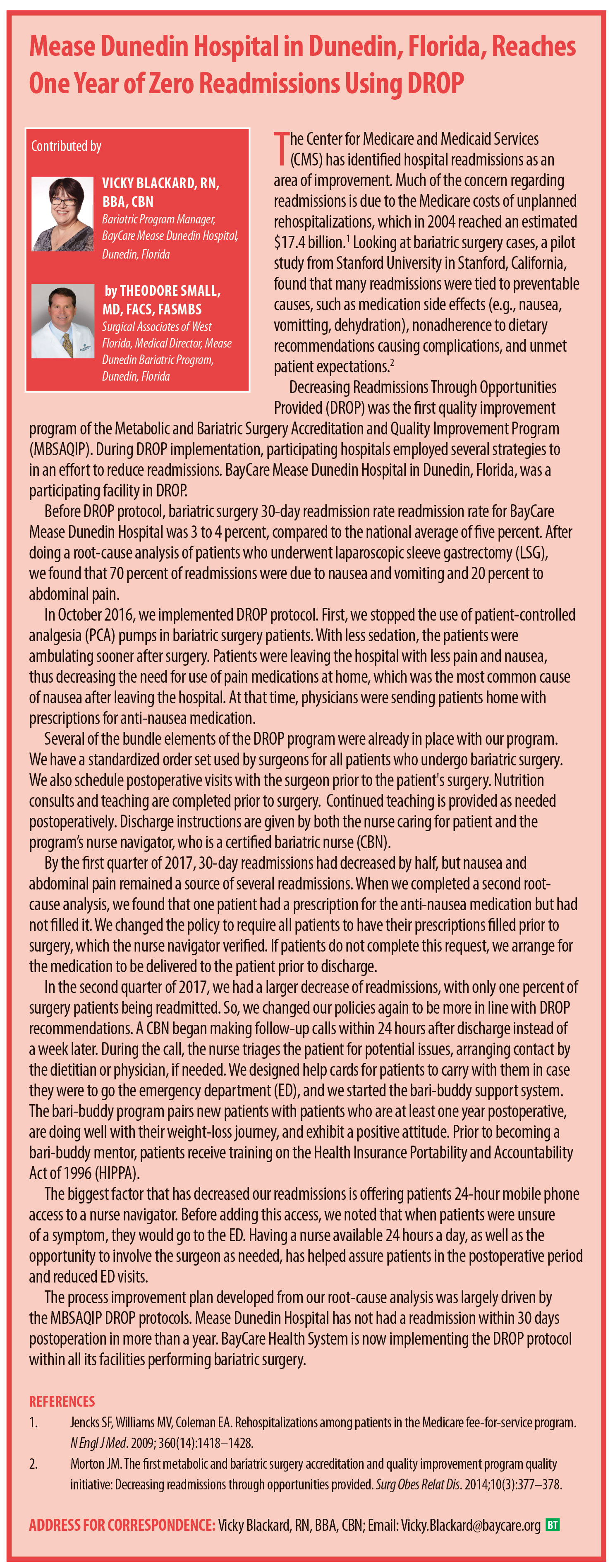Raising the Standard: DROP—The First National MBSAQIP Quality Improvement Project: Decreasing Readmissions through Opportunities Provided
 by Dominick Gadaleta, MD, FACS, FASMBS, and Anthony T. Petrick, MD, FACS, FASMBS
by Dominick Gadaleta, MD, FACS, FASMBS, and Anthony T. Petrick, MD, FACS, FASMBS
Dr. Gadaleta is Chair of the Department of Surgery at Southside Hospital and Director of Metabolic and Bariatric Surgery at North Shore University Hospital, Northwell Health in Manhasset, New York; and Associate Professor of Surgery at Zucker School of Medicine at Hofstra/Northwell in Hempstead, New York.
Dr. Petrick is Quality Director at Geisinger Surgical Institute and Director of Bariatric and Foregut Surgery at Geisinger Health System in Danville, Pennsylvania.
Bariatric Times. 2019;16(2):16.
RAISING THE STANDARD
This column series explores the ongoing strive for quality excellence in the field of bariatric surgery.
Column editors
Anthony T. Petrick, MD, FACS, FASMBS
Quality Director, Geisinger Surgical Institute; Director of Bariatric and Foregut Surgery, Geisinger Health System, Danville, Pennsylvania
Dominick Gadaleta, MD, FACS, FASMBS
Chair, Department of Surgery, Southside Hospital; Director, Metabolic and Bariatric Surgery, North Shore University Hospital, Northwell Health, Manhasset, New York; Associate Professor of Surgery, Zucker School of Medicine at Hofstra/Northwell, Hempstead, New York
 Between the years 2002 and 2009, in-hospital mortality rates for bariatric surgery decreased from 4 in 1,000 to 0.6 in 1,000.1 Credit for the 10-fold reduction in 30-day mortality is attributed to the accreditation process, the refinement of the laparoscopic approach, and emphasis on determining appropriate patient and procedure selection. On the heels of mortality reduction success in bariatric surgery, Centers for Medicare & Medicaid Services (CMS) and other insurers began emphasizing 30-day readmission rates as an increasingly important priority due to their associated costs and complications. The leadership of the American Society for Metabolic and Bariatric Surgery (ASMBS) felt this was a perfect first national quality improvement project.
Between the years 2002 and 2009, in-hospital mortality rates for bariatric surgery decreased from 4 in 1,000 to 0.6 in 1,000.1 Credit for the 10-fold reduction in 30-day mortality is attributed to the accreditation process, the refinement of the laparoscopic approach, and emphasis on determining appropriate patient and procedure selection. On the heels of mortality reduction success in bariatric surgery, Centers for Medicare & Medicaid Services (CMS) and other insurers began emphasizing 30-day readmission rates as an increasingly important priority due to their associated costs and complications. The leadership of the American Society for Metabolic and Bariatric Surgery (ASMBS) felt this was a perfect first national quality improvement project.
On March 2, 2015, led by the co-chairs of the ASMBS and American College of Surgeons (ACS) Metabolic and Bariatric Surgery Accreditation and Quality Improvement Program (MBSAQIP) Quality Sub-Committee, Stacy Brethauer, MD, FACS, FASMBS (Cleveland Clinic BMI Department of Surgery at Cleveland Clinic, Cleveland, Ohio) and Anthony Petrick, MD, FACS, FASMBS (Geisinger Health System, Danville, Pennsylvania), the program launched the Decreasing Readmissions through Opportunities Provided (DROP) project. The goal was to decrease all-cause 30-day readmissions for primary bariatric surgery at comprehensive centers by 20 percent in one year, with an estimated annual healthcare savings of $52.5 million.
Encouraged by a pilot program for DROP led by John M. Morton, MD, MPH, FACS, FASMBS (Stanford University, Stanford, California),2 which decreased readmissions by 69 percent using a readmission bundle, the MBSAQIP DROP program was designed and implemented. The readmission bundle included 1) improved patient education/discharge planning, 2) providing direct phone numbers to key clinical personnel, 3) providing registered nurse (RN) calls to each patient one day after discharge, 4) making same-day appointments available for concerns, and 5) using the Clinical Decision Unit (CDU) for 23-hour stays, which reduced the all-cause readmission rate from eight percent down to 2.5 percent. During the implementation phase, the addition of a registered dietitian (RD) to the first postoperative visit reduced diet-related readmissions from three percent to zero (p=0.001).3 This proved to be important, since benchmark MBSAQIP data indicated that most of the readmissions are from preventable causes, such as dehydration, nausea, medication side effects, and patient expectations, and a minority are from serious conditions, such as deep vein thrombosis (DVT[0.1%]), small bowel obstruction (SBO[0.2%]), leaking (0.4%), and bleeding (1%).
The DROP interventions begin at the preoperation stage and continue through the 30-day postoperative visits and beyond. Novel approaches include an educational video, a discharge checklist, follow-up phone calls by an RN, distribution of key clinical phone numbers (HELPcard®), and multiple visits with the nutritionist. The educational video features a pharmacist, surgeon, psychologist, nutritionist, and RN, all of whom discuss their roles in the prevention of readmission as well as important health-related factors within their areas of specialty on which patients should remain mindful. The development of a formal escalation process used to identify patients at high risk for readmission due to social and/or medical reasons and attention to modifiable risk factors (e.g., weight gain, diabetes control) are also in the preoperation bundle. The care team then reconciles each patient’s medications, giving the patient prescriptions for postoperative medications, and schedules postoperative appointments.
The in-patient bundle includes a clinical roadmap with fixed length of stay (LOS), an emphasis on hydration with distribution of branded water bottles, a nutritional consult, and use of a discharge checklist. Postdischarge elements include a nurse/physician assistant (PA) phone call made the day after discharge (if high risk, an additional call is made on the Friday of discharge week), one-week postoperative appointment with nutritional counseling, discharge summary and recommendations sent to the patient’s primary care physician (PCP), and a monthly readmission review conference.
In the study, DROP was implemented by 128 MBSAQIP comprehensive centers between March 2015 and March 2016 for patients undergoing primary laparoscopic adjustable gastric banding (LAGB), laparoscopic sleeve gastrectomy (LSG), or laparoscopic Roux-en-Y gastric bypass (RYGB). Fourteen members from the MBSAQIP Quality sub-committee were chosen as mentors to help with implementation, monitor adherence, and review outcomes. Over the one-year period, a steady decrease in readmissions was observed across the board, most notably for LSG. Mean LOS for patients undergoing LSG fell significantly from 1.9 days pre-DROP to 1.79 days post-DROP implementation. The DROP intervention also achieved a significant decrease in LOS for LAGB, from 0.5 to 0.42 days.
The rate of readmission within 24 hours postdischarge in patients who underwent LSG decreased significantly by 19 percent after introduction of the DROP program (p=0.007). There was also a favorable but not statistically significant decrease in readmission for LAGB and RYGB.
The analysis showed the key difference-makers were the nurse’s phone call on the day following discharge and the postoperative visits with the surgeon and nutritionist within the first several weeks. Encouraged by the great success and lessons learned from the DROP project, the second national quality improvement initiative, Employing New Enhanced Recovery Goals for Bariatric Surgery (ENERGY) was launched in 2017. This will be the subject of an upcoming column.
References
- Nguyen NT, Hohmann S, Nguyen XM, et al. Outcome of laparoscopic adjustable gastric banding and prevalence of band revision and explantation at academic centers: 2007-2009. Surg Obes Relat Dis. 2012; 8(6):724–727.
- Morton JM. The first metabolic and bariatric surgery accreditation and quality improvement program quality initiative: Decreasing readmissions through opportunities provided. Surg Obes Relat Dis. 2014;10(3):377–378.
- Garg T, Rosas U, Rogan D, et al. Characterizing readmissions after bariatric surgery. J Gastrointest Surg. 2016;20(11):1797–1801.
Category: Past Articles, Raising the Standard




